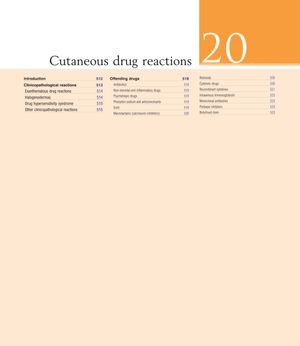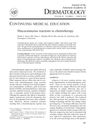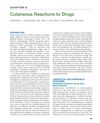Cutaneous Drug Reactions
January 2010
in “
Elsevier eBooks
”
cutaneous drug reactions antibiotics NSAIDs psychotropic drugs patch tests cytokine release assays exanthematous eruptions hypertrichosis lupus erythematosus-like reactions photosensitivity T cells genetic factors retinoids cytotoxic drugs toxic epidermal necrolysis vasculitis cytokines Sweet's syndrome TNF-α inhibitors nonsteroidal anti-inflammatory drugs TNF-alpha inhibitors

TLDR Any drug can cause skin reactions, but antibiotics, NSAIDs, and psychotropic drugs are more common, with some reactions being life-threatening.
The 2010 document provides a comprehensive overview of cutaneous drug reactions, which are adverse skin responses to medications. It states that while any drug can cause a reaction, antibiotics, NSAIDs, and psychotropic drugs are more commonly implicated. The prevalence of these reactions is around 2% among inpatients, with 2% of these being life-threatening. Diagnosis is challenging due to the variety of drugs a patient may take and the similarity of reactions to other skin conditions. Tests like patch tests and cytokine release assays can help identify the offending drug, with some tests confirming over 50% of suspected cases. The document explains that drug reactions can be toxic, metabolic, or allergic, with less than 20% being immunological. Women and patients with Sjögren's syndrome or AIDS are at higher risk. The document also details various specific reactions, such as exanthematous eruptions, hypertrichosis, lupus erythematosus-like reactions, and photosensitivity, and discusses the role of T cells and genetic factors in these reactions. It further outlines the diverse cutaneous side effects of different drug classes, including NSAIDs, psychotropic drugs, retinoids, and cytotoxic drugs, and notes the potential for serious reactions like toxic epidermal necrolysis and vasculitis. The document concludes by listing various therapeutic agents and their associated skin reactions, such as cytokines causing Sweet's syndrome and TNF-α inhibitors increasing infection risk, and provides a table of drugs and their classifications.









